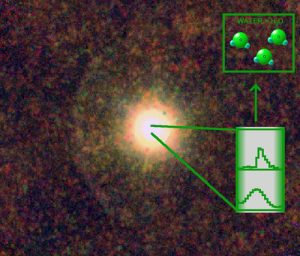| Basic Information | |
| What is this? | The red giant carbon star CW Leonis |
| Where is it in the sky? | In the constellation of Leo the Lion |
| How big is it? | The star is about 500 times the diameter of our Sun, and is ejecting is outer layers |
| How far away is it? | About 500 light years |
| What do the colours represent? | The brighter colours are glowing gas and dust, with the bow shock on the left showing where the material from the star is meeting the interstellar medium |
Downloads
See this object in:
The red giant carbon star CW Leonis is too bright to be seen well by the SPIRE and PACS cameras, but it is releasing material in a violent stellar wind. Some of that material is seen as a “bow shock” to the left of the star in this image, glowing as it piles up against the interstellar medium. Observations with the PACS and SPIRE spectrometers have shown that water vapour is being formed deep down near the surface of the star; a place where it was previously thought to be impossible.
When astronomers discovered an unexpected cloud of water vapour around the old star CW Leonis in 2001, using the Submillimeter Wave Astronomy Satellite (SWAS), they immediately began searching for the source. Water is known to be present around several types of stars, but CW Leonis is a “carbon star” and therefore thought not to produce water. Initially they suspected the star’s heat must be evaporating comets or even dwarf planets to produce the water.
CW Leonis is a red giant star which is only a few times the mass of the Sun but has expanded to hundreds of times its size. Nuclear fusion reactions deep inside the star are converting helium into carbon, much of which has ended up in the outer layers of the star’s atmosphere. It is this abundance of Carbon in the atmospheres of these types of stars that has previously led scientists to believe that water could not exist; with so much carbon all of the oxygen should be locked up in carbon monoxide (CO).
Now, the SPIRE and PACS spectrometers have shown that the water vapour is being formed much closer to the star itself than previously thought, at temperatures approaching 1000oC. These results, published in Nature, suggests that the water is being created by a previously unsuspected chemical process where ultraviolet radiation from interstellar space is breaking up the carbon monoxide and releasing oxygen atoms that can then react with hydrogen to form water molecules.

Ultraviolet starlight would normally be blocked by the material flowing from the star as its outer layers billow out in a stellar wind. It was already known that the stellar wind is “clumpy” but the Herschel results have shown that some regions around the star must have no wind. These empty regions allow the ultraviolet light to reach the deepest layers of the star’s atmosphere and initiate the chemical reactions that produce the water.
The water is detected by the fact that it preferentially emits light with specific wavelengths, with the relative brightnesses of the “emission lines” indicating the conditions in which the water is forming. The wavelength range of the SPIRE and PACS spectrometers, between them covering 60–670 micrometers (frequencies of 0.45–5 THz), allows astronomers to detect elements and molecules previously impossible. The wide range now also makes it possible to determine the temperature od the environment in which the water is forming, which wasn’t possible before.

